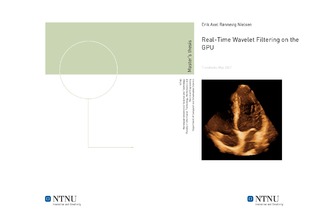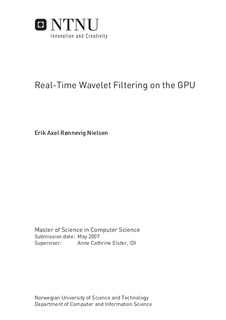| dc.contributor.advisor | Elster, Anne Cathrine | nb_NO |
| dc.contributor.author | Nielsen, Erik Axel Rønnevig | nb_NO |
| dc.date.accessioned | 2014-12-19T13:33:31Z | |
| dc.date.available | 2014-12-19T13:33:31Z | |
| dc.date.created | 2010-09-04 | nb_NO |
| dc.date.issued | 2007 | nb_NO |
| dc.identifier | 348436 | nb_NO |
| dc.identifier | ntnudaim:3580 | nb_NO |
| dc.identifier.uri | http://hdl.handle.net/11250/251148 | |
| dc.description.abstract | The wavelet transform is used for several applications including signal enhancement, compression (e.g. JPEG2000), and content analysis (e.g. FBI fingerprinting). Its popularity is due to fast access to high pass details at various levels of granularity. In this thesis, we present a novel algorithm for computing the discrete wavelet transform using consumer-level graphics hardware (GPUs). Our motivation for looking at the wavelet transform is to speed up the image enhancement calculation used in ultrasound processing. Ultrasound imaging has for many years been one of the most popular medical diagnostic tools. However, with the recent introduction of 3D ultrasound, the combination of a huge increase in data and a real-time requirement have made fast image enchancement techniques very important. Our new methods achieve a speedup of up to 30 compared to SIMD-optimised CPU-based implementations. It is also up to three times faster than earlier proposed GPU implementations. The speedup was made possible by analysing the underlying hardware and tailoring the algorithms to better fit the GPU than what has been done earlier. E.g. we avoid using lookup tables and dependent texture fetches that slowed down the earlier efforts. In addition, we use advanced GPU features like multiple render targets and texture source mirroring to minimise the number of texture fetches. We also show that by using the GPU, it is possible to offload the CPU so that it reduces its load from 29% to 1%. This is especially interesting for cardiac ultrasound scanners since they have a real-time requirement of up to 50 fps. The wavelet method developed in this thesis is so successful that GE Healthcare is including it in their next generation of cardiac ultrasound scanners which will be released later this year. With our proposed method, High-definition television (HDTV) denoising and other data intensive wavelet filtering applications, can be done in real-time. | nb_NO |
| dc.language | eng | nb_NO |
| dc.publisher | Institutt for datateknikk og informasjonsvitenskap | nb_NO |
| dc.subject | ntnudaim | no_NO |
| dc.subject | SIF2 datateknikk | no_NO |
| dc.subject | Komplekse datasystemer | no_NO |
| dc.title | Real-Time Wavelet Filtering on the GPU | nb_NO |
| dc.type | Master thesis | nb_NO |
| dc.source.pagenumber | 90 | nb_NO |
| dc.contributor.department | Norges teknisk-naturvitenskapelige universitet, Fakultet for informasjonsteknologi, matematikk og elektroteknikk, Institutt for datateknikk og informasjonsvitenskap | nb_NO |

